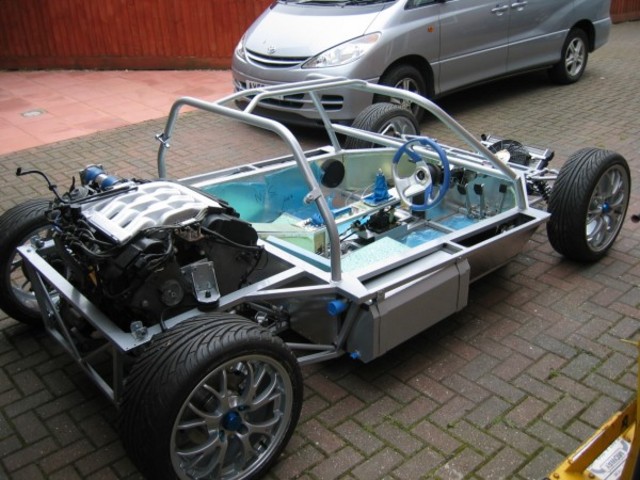.jpg)

I'm in the depths of chassis design, and being able to see the light at the end of the tunnel, I started drafting some overlays for the body work
on top of the chassis.
As things turn out, I have capacity for a larger frame under the shell, so here's my question.
Should I make a bigger frame?
Clearly, if I simply make the triangles bigger, with the same size tubes, it will be weaker - more prone to bending in the elements.
So I could go for a bigger frame, with more structure in it, but that would add weight.
So I'm thinking - could I put in more structure, but go for, say, 19mm primaries with 12mm secondaries?
It needs to be strong, as it will have circa 350BHP running through it. Whilst weight is always a concern, particularly in the chassis where it's
nigh on impossible to remove it later, this has never been inteneded to be a mega-light 500kg vehicle. 800kgs will be fine.
[Edited on 4/2/08 by Jesus-Ninja]
personally if the frame was similar to the 7's I would prefer to increase the thickness of the rails that make up the sides of the passenger
compartment in case of a T-bone accident. This is the area the 7 is most deficient in.
[Edited on 4/2/08 by Mr Whippy]
I'd look at thinner wall tubes rather than smaller diameter. Do you actually need the chassis to fill the bodywork? Is there any advantage? No and No? Leave it.
If you look at the design attached, I think there is capacity for the upper engine bay rail to run up to the bend in the cage, at the base of the
windscreen. Would this not improve rigidity?.jpg)
Perhaps the tubes rearranged as below in orange would enhance the strength
Rescued attachment car.JPG
also I think I remember that this was quite a wide car, so one thing you could do is make the sides into trusses like this particularly dreadful
sketch. Doing that would make the car a lot stiffer and safer in a side impact.
Rescued attachment truss.JPG
To quote Peter Elleray: "As regards the overall level of stiffness, it is an order of magnitude higher than the roll stiffness of the suspension,
which is usually a good rule of thumb to work to…" from here
The more effective cross sectional area you take up in in the chassis the stiffer it will be.
So I'd advise using all the space under the frame to get the thing as stiff as you can.
As a side note it'll be safer too as you can get seated further in from the frame, so it has to crush more before you start getting crushed.
If you look at Fred W B's car he's effectively used side pods to gain substantial frame stiffness. He's got the numbers somewhere I
believe it was a good improvement over without them on.
http://www.locostbuilders.co.uk/photos.php?action=showphoto&photo=sf%20proto%20canamsa%20side%20pod.jpg
http://www.locostbuilders.co.uk/photos.php?action=showphoto&photo=sf%20proto%20canamsa%20torsion%20test.jpg
[Edited on 4/2/08 by Doug68]
[Edited on 4/2/08 by Doug68]
what ever you doing it ain't working as i still can't see those pictures 

oh that's better, cool chassis. Kind of what I was going on about but better 
[Edited on 4/2/08 by Mr Whippy]
fecking feck feck fecking thing. 
quote:
Originally posted by Mr Whippy
Perhaps the tubes rearranged as below in orange would enhance the strength
.jpg)
My chassis has extra side rails to improve stiffness and offer a little more side impact protection.


Rescued attachment Rolling Chassis.jpg
quote:
Originally posted by RazMan
My chassis has extra side rails to improve stiffness and offer a little more side impact protection.
